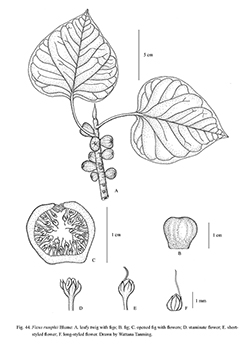e-Flora of Thailand
Volume 10 > Part 4 > Year 2011 > Page 638 > Moraceae > Ficus
URO33. Ficus rumphii Blumewfo-0000690150
Bijdr. Fl. Ned. Ind.: 437. 1825; Miq., Ann. Mus. Bot. Lugd. Bat. 3: 287. 1867; Kurz, Forest Fl. Burma 2: 448. 1877; King, Ann. Roy. Bot. Gard. (Calcutta) 1(1): 54, t. 67B. 1887; Ridl., Fl. Malay Penins. 3: 337. 1924; Gagnep., Fl. Indo-Chine 5: 768. 1928; C.C.Berg & Corner, Fl. Males., Ser. 1, Spermat. 17(2): 609. 2005.— Urostigma rumphii (Blume) Miq. in Zoll., Syst. Verz. 2: 90. 1854. Fig. 44.
Accepted Name : This is currently accepted.
Synonyms & Citations :
Description : Tree to 20 m tall or shrub, hemi-epiphytic or terrestrial, deciduous. Branches drying brown to yellowish. Leafy twigs 2–5 mm thick, slightly angular to subterete, glabrous or (minutely) white puberulous (on the stipule scars and petiole bases); periderm flaking off. Leaves spirally arranged; lamina (broadly) ovate (to elliptic), (3–)5–16 by (3–)4–12 cm, (sub) coriaceous, apex acuminate to acute, the acumen sharp, base truncate, subcordate or broadly cuneate, often slightly decurrent; both surfaces glabrous; cystoliths only below; lateral veins 6–8 pairs, the major basal pair to ⅓–½ the length of the lamina, mostly branched, always with a pair of smaller basal lateral veins (unbranched or faintly branched) below the major pair, the other lateral veins sometimes forked away from the margin, tertiary venation reticulate to subscalariform; waxy gland at the base of the midrib, above the bases of the minor basal lateral veins; petiole (2.5–)4–6(–9) cm long, 1.5–2 mm thick, glabrous, stipules (0.5–)1–3.5 cm long, glabrous, caducous. Figs axillary or just below the leaves, in pairs (or solitary), sessile; basal bracts (2–)3, 1–2 mm long, glabrous, persistent; receptacle subglobose, 0.9–1.2(–1.5) cm diam. when dry and the surface often wrinkled, ca 1.5–2 cm diam. when fresh, glabrous, turning from pink to purple to black at maturity, apex convex to concave, ostiole 2–2.5 mm diam., flat, the upper ostiolar bracts glabrous; internal hairs absent. Staminate flowers scattered. Tepals (dark) red. Ovary white.
Thailand : NORTHERN: Mae Hong Son, Chiang Mai, Lampang; NORTH-EASTERN: Sakon Nakhon; EASTERN: Si Sa Ket; SOUTH-WESTERN: Prachuap Khiri Khan; CENTRAL: Saraburi; SOUTH-EASTERN: Chon Buri; PENINSULAR: Phangnga, Songkhla, Pattani.
Distribution : Cocos Islands, Pakistan, Nepal, Bhutan, India (Peninsular, NE, Andaman and Nicobar Islands), Bangladesh, Burma, Laos, Vietnam, Cambodia, Peninsular Malaysia, Indonesia (Java – type, Lesser Sunda Islands, Sulawesi, Moluccas).
Ecology : Mixed deciduous, dry evergreen and evergreen forests, at low altitude, also planted as a temple tree (in place of Ficus religiosa).
Vernacular : Pho khi nok (โพขี้นก), pho tua phu (โพตัวผู้), pho prasat (โพประสาท)(Central).

